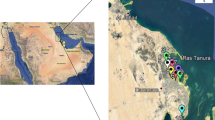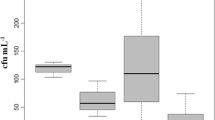Abstract
Pathogenic bacteria of Scophthalmus maximus enteritis were isolated from and identified in an aquaculture farm in Changli County, Hebei Province, China. The feasibility of rapid selection of prevention and treatment drugs via PCR technology was investigated through drug resistance phenotype analysis and drug resistance gene detection. A dominant bacterial strain was isolated from S. maximus and designated HC-1. Morphological observations, culture property investigations, and physiological-biochemical experiments were conducted, which showed that the strain was consistent with the phenotypic characteristics of Vibrio. Based on 16S rRNA sequence determination and homology analysis, HC-1 was determined to be 99.65% similar to Vibrio harveyi NR 043165.1. Therefore, the bacterium was identified as V. harveyi. The sensitivity of the V. harveyi isolate to 41 antibiotics was determined by the Kirby-Bauer method. The results showed that HC-1 was resistant to 8 agents, namely, penicillin, oxacillin, amoxicillin, ampicillin, spectinomycin, azithromycin, florfenicol, and carbenicillin. The antimicrobial resistance gene analysis results showed that tem, ant(3˝)-I and tetA are carried by the chromosome of the strain and the plasmid, while sul1 is carried by the chromosome of the strain but not the plasmid. In contrast, floR is carried only by the plasmid but not by the chromosome. vanA, qnrA, and mefA are not carried by the plasmid or chromosome of the strain. Although the resistant phenotype of the strains is regulated by resistance genes, the relationship between the phenotype and genotype should be revealed by numerous databases. To accelerate the speed of treatment selection, it is necessary to apply PCR technology to detect resistance genes to replace drug sensitivity testing. These results provide useful information for further understanding the antimicrobial resistance factors and treatment of bacterial disease in S. maximus.




Similar content being viewed by others
Data availability
All data during this study are available from the author.
References
Atujona D, Huang YC, Wang ZW, Jian JC, Cai SH (2019) Vibrio harveyi (VirB11) recombinant vaccine development against vibriosis in orange-spotted grouper (Epinephelus coioides). Aquac Res 50(9):2628–2634
Brenner DJ, Krieg NR, Staley JT (2008) Bergey’s Manual of Systematic Bacteriology (second edition). Volume 2. Springer. 546–551.
Clinical and Laboratory Standards Institute (2018) . Performance standards for antimicrobial disk susceptibility test, approved standard. 13th Edition. Wayne, PA: CLSI; 2018 CLSI standard M02 guidelines
Gao XJ, Yao DR, Sun JJ, Bai XS, Miu YH, Zhang YY, Bi KR, Qin L, Zhang XJ (2015) Identification of 4 pathogenic Vibrio harveyi strains isolated from diseased Oyster(Crassostrea gigas) and detection of their virulence genes. Trans Oceanol Limnol 3:87–96
Guan CT (2016) Annual Report 2015 of National Technology System for Flatfish Culture Industry (in Chinese). China Ocean University Press, Qingdao, pp 179–242
Guo GX, Li C, Xia B, Jiang SH, Zhou S, Men XH, Ren YC (2020) The efficacy of lactic acid bacteria usage in turbot Scophthalmus maximus on intestinal microbiota and expression of the immune related genes. Fish Shellfish Immun 100:90–97
Hou XJ, Wu KM, Mo GD, Liu S, Yan T, Jiao P, Wei P (2016) Evaluation of drug-resistant phenotypes and genes of foodborne Salmonella isolates. Food Sci 37(19):166–170
Joseph A, Philip R (2020) Immunocompetence of Penaeus monodon under acute salinity stress and pathogenicity of Vibrio harveyi with respect to ambient salinity. Fish Shellfish Immun 106:555–562
Kariuki S, Gordon MA, Feasey N (2015) Antimicrobial resistance and management of invasive Salmonella disease. Vaccine 33(3):21–29
Lei JL, Liu XF (2010) Culture of turbot: Chinese perspective. Wiley‐Blackwell 185-202
Miao PF, Yang Y, Tan SW, Chen Y, Peng Z, Wu YL, Yu H (2018) Identification and antibiotic susceptibility of pathogenic bacterium Vibrio alginolyticus from diseased giant freshwater prawn Macrobrachium rosenbergii. Fish Sci 37(3):384–388
Miranda CD, Godoy FA, Lee MR (2018) Current status of the use of antibiotics and the antimicrobial resistance in the Chilean Salmon farms. Front Microbiol 9:1284
Musa N, Wei LS, Wee W (2008) Phenotypic and genotypic characteristics of Vibrio harveyi isolated from black tiger shimp (Penaeus monodon). World Appl Sci J 3(6):885–902
Ramesh A, Venudopalan VK (1989) Response of enteric luminous bacteria to environmental conditions in the gut of the fish. J Appl Microbiol 66(6):529–533
Ransangan J, Imm LKL, Lal TM, Sade A (2013) Phenotypic characterization and antibiotic susceptibility of Vibrio spp. isolated from aquaculture waters on the west coast of Sabah, Malaysia. Int J Res Pure Appl Microbio 3(3):58–66
Shen P, Fan X R, Li G W. Microbiology experiment (1999). Beijing, china
Soto-Rodriguez SA, Gomez-Gil B, Lozano R (2012) Virulence of Vibrio harveyi responsible for the “Bright-red” Syndrome in the Pacific white shrimp Litopenaeus vannamei. J Invertebr Pathol 109(3):307–317
Torrecillas S, Caballero MJ, Mompel D, Montero D, Zamoran MJ, Robaina OL, Rivero-Ramírez F, Karalazos V, Kaushik S, Izquierdo M (2017) Disease resistance and response against Vibrio anguillarum intestinal infection in European seabass (Dicentrarchus labrax) fed low fish meal and fish oil diets. Fish Shellfish Immun 67:302–311
Wang XA, Ma AJ (2016) Comparison of four nonlinear growth models for effective exploration of growth characteristics of turbot Scophthalmus maximus fish strain. Afr J Biotechnol 15(40):8
Wang RX, Geng YJ, Feng J, Wang JY (2015) Identification and analysis of resistant plasmid of pathogenic bacteria Vibrio harveyi isolated from Haliotis diversicolor. S Chi Fish Sci 8(2):1–6
Wang C, Hu RW, Strong PJ, Zhuang W, Shu L (2020) Prevalence of antibiotic resistance genes and bacterial pathogens along the soil-mangrove root continuum. J Hazard Mater 408:124985. https://doi.org/10.1016/j.jhazmat.2020.124985
Wu TL, Zhang ZQ, Li QL, Wang HB, Ren H, Gao GS, Shi QM (2018) Bioactivity and component analysis of extracellular products of Photobacterium damselae isolated from turbot. Chi J Vet Sci 38(8):1539–1542+1591
Zeng DQ, Feng J, Xu LW, YL SU, Guo ZX (2015) Antibiogram tupes of Vibrio harveyi strains isolated from maricultured fish. J Fish Sci Chi 22(1):129–138
Zhang KK, Mai KS, Xu W (2017) Effects of dietary arginine and glutamine on growth performance, nonspecific immunity, and disease resistance in relation to arginine catabolism in juvenile turbot (Scophthalmus maximus L.). Aquaculture 1:246–254
Zhang YG, Luan LL, Ren H, Ge MX, Jin XM, Ye SG (2018) Antibacterial effect of Chinese herbal medicines against Vibrio harveryi isolated from Scophthalmus maximus in vitro. Fres Fish 48(3):78–82
Zhu ZM, Duan C, Dong CF, Weng SP, He JG (2020) Epidemiological situation and phylogenetic relationship of Vibrio harveyi in marine-cultured fishes in China and Southeast Asia. Aquaculture 529:735652
Acknowledgments
The authors of this manuscript are thankful to the Analysis and Testing Center of Hebei Normal University of Science and Technology for its kind support and help in preparing this review article.
Funding
This work was supported by the National Natural Science Foundation of China (31502187); the Major Science and Technology Projects of Hebei Province (202867012); the Natural Science Foundation of Hebei Province, China (C2018407049), the Science and Technology Projects of Hebei Province (20567621H); and the Marine Special Foundation of Hebei Normal University of Science and Technology (2018HY022), which are gratefully acknowledged.
Author information
Authors and Affiliations
Contributions
Yongzhu Yuan wrote the rough draft of the manuscript.
Yonggang Zhang made detailed supplements and modifications to the whole article.
Mrs. Xiaomin Jin designed the experimental scheme, collected the experimental data, and coordinated the revision of the entire article.
Mr. Guoshan QI, Mr. Hai Fang, and Mr. Hai Ren made important contributions to the conception, design and modification of the article.
Corresponding authors
Ethics declarations
Ethical approval
All applicable international, national, and/or institutional guidelines for the care and use of animals were followed by the authors.
Consent to participate
All the authors agreed to participate in this research.
Consent for publication
All the authors agreed to publish this manuscript.
Competing interests
The authors declare that they have no competing interests.
Additional information
Publisher’s note
Springer Nature remains neutral with regard to jurisdictional claims in published maps and institutional affiliations.
Rights and permissions
About this article
Cite this article
Yuan, Y., Zhang, Y., Qi, G. et al. Isolation, identification, and resistance gene detection of Vibrio harveyi from Scophthalmus maximus. Aquacult Int 29, 2357–2368 (2021). https://doi.org/10.1007/s10499-021-00752-z
Received:
Accepted:
Published:
Issue Date:
DOI: https://doi.org/10.1007/s10499-021-00752-z




